Audenshaw
Audenshaw is a town[1] in Tameside, Greater Manchester, England, 4.9 miles (7.9 km) east of Manchester. Historically part of Lancashire, in 2011 it had a population of 11,419.[2]
| Audenshaw | |
|---|---|
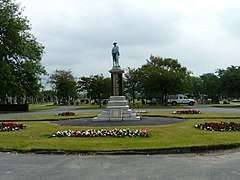 Audenshaw Cemetery | |
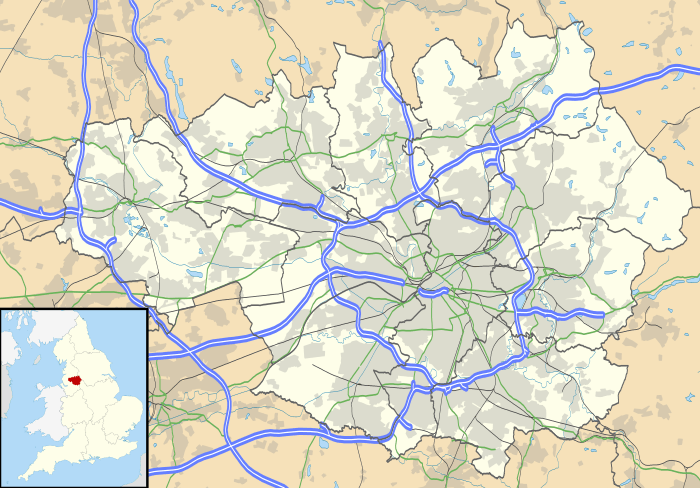 Audenshaw Location within Greater Manchester | |
| Population | 11,419 (2011) |
| OS grid reference | SJ925975 |
| • London | 160 mi (257 km) SSE |
| Metropolitan borough | |
| Metropolitan county | |
| Region | |
| Country | England |
| Sovereign state | United Kingdom |
| Post town | MANCHESTER |
| Postcode district | M34 |
| Dialling code | 0161 |
| Police | Greater Manchester |
| Fire | Greater Manchester |
| Ambulance | North West |
| UK Parliament | |
The name derives from Aldwin, a Saxon personal name, and the Old English suffix shagh meaning "Woodland". Nico Ditch, an early-medieval linear earthwork possibly built as a defensive barrier against Vikings, runs through the area. Medieval Audenshaw was a division of the township of Ashton in the county of Lancashire.[1] Audenshaw expanded as a centre for textile manufacture during the Industrial Revolution and the Victorian era with inhabitants employed in hat-making, cotton-spinning, calico-printing, and silk-weaving.[3] In 1974, Audenshaw Urban District became part of the Metropolitan Borough of Tameside.
History
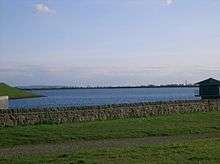
The name Audenshaw is a corruption of its earlier name Aldwinshagh which derives from Aldwin, a Saxon personal name, combined with the Old English suffix shagh meaning "Woodland".[4]
Nico Ditch, a medieval linear earthwork, runs through the area. Stretching 6 miles (9.7 km) from Ashton Moss in the east to just east of Stretford in the west, the origin of the ditch is unclear.[5] According to legend, it was completed in a single night by the inhabitants of Manchester, as a protection against Viking invaders in 869–870,[6] and that it was the site of a bloody battle between Saxons and Danes and that Gorton and Reddish got their name from the battle, "Gore Town" and "Red-Ditch".[7][8] Despite the legend, the U-shape of the ditch – as opposed to the usual V-shape of military earthworks – and the absence of an associated bank indicates that Nico Ditch was probably a boundary marker.[9] Although it is thought to be earlier, the earliest documented reference to Nico Ditch is in a charter detailing the granting of land in Audenshaw to the monks of the Kersal Cell. In the document, dating from 1190 to 1212, the ditch is referred to as "Mykelldiche", and a magnum fossatum, Latin for "large ditch".[10]
In 1877, part of the original village of Audenshaw was demolished to make way for the three Audenshaw Reservoirs. Also destroyed to allow the construction of the reservoirs was a section of Nico Ditch.[11]
Governance
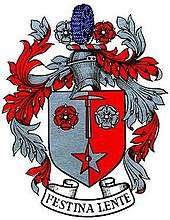
During the Early Middle Ages Audenshaw is supposed to have been a thanage held by Saxons,[4] but following the Norman conquest of England fell within the historic county boundaries of Lancashire, and noted as a division of Ashton, an ancient township and parish within the hundred of Salford.[1] The division of Audenshaw spanned the village of Audenshaw, and the outlying settlements of Danehead, Hooleyhill, Littlemoss, North-street, Walkmill, Waterhouses and Woodhouses.[4] This arrangement persisted until the creation of Audenshaw's first local authority, a local board of health in 1870.[1] Audenshaw Local Board of Health was a regulatory body responsible for standards of hygiene and sanitation in the locality. Under the Local Government Act 1894, the area of the local board became the Audenshaw Urban District, a local government district in the Ashton-under-Lyne Poor Law Union and administrative county of Lancashire.[1] Under the Local Government Act 1972, the Audenshaw Urban District was abolished, and Audenshaw has, since 1 April 1974, formed an unparished area of the Metropolitan Borough of Tameside, within the Metropolitan county of Greater Manchester.[1]
Audenshaw is represented in Parliament by the Denton and Reddish constituency. Since its creation in 1983, the constituency has been held by the Labour Party, At 53°28′27.5″N 2°6′44″W (53.4743°, −2.1122°), 160 miles (257 km) north-northwest of central London and 5 miles (8 km) east of Manchester, Audenshaw stands at the head of the Dane valley.[4] Guide Bridge is an area of Audenshaw.[13]
The Member of Parliament for the Denton and Reddish constituency since 2005 has been Andrew Gwynne MP, representing the Labour Party. His majority in the 2005 general election was 13,498 over the Conservative candidate Julie Searle.
| Constituency | Holder | |
|---|---|---|
| Denton and Reddish | Andrew Gwynne |
Audenshaw is an electoral ward of Tameside, England.[14]
The ward is represented by three councillors: Oliver Ryan (Lab),[15] Maria Bailey (Lab),[16] and Teresa Smith (Lab)[17]
| Election | Councillor | Councillor | Councillor | |||
|---|---|---|---|---|---|---|
| 2004 | Allison Seabourne (Lib Dem) | Peter Wright (Lib Dem) | Karen Wright (Lib Dem) | |||
| 2006 | Colin White (Lab) | Peter Wright (Lib Dem) | Karen Wright (Lib Dem) | |||
| 2007 | Colin White (Lab) | Wendy Brelsford (Lab) | Karen Wright (Lib Dem) | |||
| 2008 | Colin White (Lab) | Wendy Brelsford (Lab) | Jean Brazil (Lab) | |||
| 2010 | Colin White (Lab) | Wendy Brelsford (Lab) | Jean Brazil (Lab) | |||
| 2011 | Colin White (Lab) | Maria Bailey (Lab) | Jean Brazil (Lab) | |||
| 2012 | Colin White (Lab) | Maria Bailey (Lab) | Teresa Smith (Lab) | |||
| 2014 | Oliver Ryan (Lab) | Maria Bailey (Lab) | Teresa Smith (Lab) | |||
| 2015 | Oliver Ryan (Lab) | Maria Bailey (Lab) | Teresa Smith (Lab) | |||
| 2016 | Oliver Ryan (Lab) | Maria Bailey (Lab) | Teresa Smith (Lab) | |||
| 2018 | Oliver Ryan (Lab) | Maria Bailey (Lab) | Teresa Smith (Lab) | |||
indicates seat up for re-election.
Demography
| Audenshaw compared | |||
|---|---|---|---|
| 2001 UK census | Audenshaw[18] | Tameside[19] | England |
| Total population | 12,790 | 213,043 | 49,138,831 |
| White | 96.5% | 91.2% | 91% |
| Asian | 1.6% | 5.6% | 4.6% |
| Black | 0.3% | 1.2% | 2.3% |
According to the Office for National Statistics, at the time of the United Kingdom Census 2001, Audenshaw had a population of 12,790. The 2001 population density was 10,860 inhabitants per square mile (4,193/km2), with a 100 to 93.2 female-to-male ratio.[20] Of those over 16 years old, 28.4% were single (never married), 43.3% married, and 8.8% divorced.[21] Audenshaw's 5,260 households included 29.0% one-person, 38.5% married couples living together, 8.8% were co-habiting couples, and 11.4% single parents with their children.[22] Of those aged 16–74, 33.4% had no academic qualifications, similar to the Tameside average (35.2%), but above that of England (28.9%).[19][23]
In 1951 the breakdown of social class in Audenshaw was recorded as 22.7% middle class and 19.3% working class. By 1971, this had changed to 23.4 middle class and 17.2% working class. The rest of the population was made up of clerical workers and skilled manual workers.[24]
At the 2001 UK census, 80.28% of Audenshaw's residents reported themselves as being Christian, 1.1% Muslim, 0.6% Hindu, 0.3% Buddhist, and 0.1% Sikh. The census recorded 11.0% as having no religion, 0.2% had an alternative religion and 6.7% did not state their religion.[25]
Population change
| Population growth in Audenshaw since 1801 | |||||||||||||||||||||
|---|---|---|---|---|---|---|---|---|---|---|---|---|---|---|---|---|---|---|---|---|---|
| Year | 1801 | 1811 | 1821 | 1831 | 1841 | 1851 | 1861 | 1871 | 1881 | 1891 | 1901 | 1911 | 1921 | 1931 | 1939 | 1951 | 1961 | 1971 | 1981 | 1991 | 2001 |
| Population | 2,275 | 2,772 | 3,781 | 4,891 | 5,374 | 5,427 | 6,327 | 7,024 | 7,308 | 7,958 | 7,216 | 7,977 | 7,876 | 8,461 | 12,015 | 12,661 | 12,122 | 11,901 | 10,771 | 13,173 | 12,790 |
| Source:A Vision of Britain through Time[26][27][28] | |||||||||||||||||||||
Notable people
- Matthew Hughes (born 1950): politician, born in Audenshaw; Was the distinguished Principal of John Septamus Roe in Perth who grew the school from a small school in Mirrabooka to the largest private school in the state of WA. Matthew went on to become the first Labor party Member of the Legislative Assembly for the electorate of Kalamunda.
- Lonelady: 21st-century singer and guitarist, real name Julie Campbell, comes from Audenshaw
- Ellis Plummer (born 1994): Manchester City footballer; born in Audenshaw[29]
- Brooke Vincent (born 1992): actress, Sophie Webster in Coronation Street; born in Audenshaw
Transport
Audenshaw was once served by a mainline railway station. The station closed in 1950. The town is now served by a tram stop on the East Manchester line of the Manchester Metrolink, providing services westbound to Eccles and MediaCityUK and eastbound to Ashton-under-Lyne.
Economy
| Audenshaw compared | |||
|---|---|---|---|
| 2001 UK Census | Audenshaw[30] | Tameside[31] | England |
| Population of working age | 9,151 | 152,313 | 35,532,091 |
| Full-time employment | 45.9% | 43.5% | 40.8% |
| Part-time employment | 11.9% | 11.5% | 11.8% |
| Self-employed | 6.8% | 6.5% | 8.3% |
| Unemployed | 2.8% | 3.3% | 3.3% |
| Retired | 13.5% | 13.3% | 13.5% |
Prior to the Industrial Revolution, the main occupation in Audenshaw was that of farming. The earliest recorded agriculture in the Tameside area was in Audenshaw in the period 1190–1212.[32] As was the case in neighbouring Denton, in the 19th century most of Audenshaw's residents were occupied in the hatting industry, the manufacture of cotton and silk, and calico printing.[4]
According to the 2001 UK census, the industry of employment Audenshaw's residents aged 16–74 was 20.3% manufacturing, 18.7% retail and wholesale, 10.1% property and business services, 9.0% health and social work, 8.2% construction, 6.8% transport and communications, 6.3% education, 6.2% public administration, 5.2% finance, 3.8% hotels and restaurants, 0.9% energy and water supply, 0.4% agriculture, 0.1% mining, and 4.0% other. Compared with national figures, the town had a relatively high percentage of residents working in manufacturing (14.8% in England).[33]
The census recorded the economic activity of residents aged 16–74, 2.2% students were with jobs, 3.0% students without jobs, 4.7% looking after home or family, 6.5% permanently sick or disabled, and 2.7% economically inactive for other reasons.[30]
Landmarks
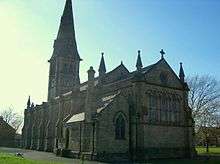
There are nine Grade II listed buildings in Audenshaw, although no Grade I or II*.[34] These include two lodges which were originally a single barn,[35][36] a trough and pillar,[37] and St Stephen's Church. The church was constructed in 1846, at a cost of £2,900 (equivalent to £280,000 in 2020)[38] and provided space for a congregation of 750.[39]
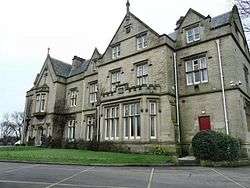
Ryecroft Hall, a Grade II listed building,[40] was donated to the people of Audenshaw by the local Member of Parliament, Austin Hopkinson, in 1921.
The war memorial at the entrance to Audenshaw Cemetery is also a Grade II listed building and commemorates the 140 men from Audenshaw who lost their lives in World War I. Standing 15 feet (4.6 m), it features a bronze statue of a soldier standing on top of a square column. There are slabs of black granite on the fours sides of the column with the names of the deceased. Unveiled in 1920 before a 10,000 strong crowd, it cost £1,300 (£50,000 in 2020).[38][41]
Education
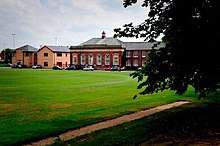
There are two nursery schools,[42] five primary schools,[43] and one secondary school in Audenshaw.[44] Opened in 1932 as Audenshaw Grammar School for Boys,[39] Audenshaw School is now the only secondary school in the town. In 2008, the school was the most successful in the borough in terms of proportion of pupils attaining five or more A*–C grades at General Certificate of Secondary Education (GCSE) including maths and English (64% in Audenshaw School compared with the average of 41.8% for Tameside and 47.6% for England)[45][46] and most points per pupil at A-level.[47] It is a specialist technology college.[48] Until 1964, secondary education was also provided by Poplar Street Primary School which was built in 1914, although its primary school still exists.[39]
Sport
The Audenshaw Greyhound Racing and Sports Ground existed from the turn of the 20th century, initially as an athletic and coursing ground and then as a trotting track, speedway dirt track and greyhound racing track until 1934. This is not to be confused with the Athletics stadium that existed on the south side of the Manchester Road.[49] Audenshaw is also home to the historic rugby club Aldwinians RUFC, once captain by England's rugby union captain from 1956 to 1958, Eric Evans MBE.
See also
References
Notes
- Greater Manchester Gazetteer, Greater Manchester County Record Office, Places names – A, archived from the original on 18 July 2011, retrieved 4 September 2009
- "2011 census". Retrieved 5 February 2015.
- Great Britain Historical GIS Project (2004), "Descriptive Gazetteer Entry for Audenshaw", A vision of Britain through time, University of Portsmouth, retrieved 4 September 2009
- Lewis 1848, pp. 112–116.
- Nevell 1998, p. 40.
- Hylton 2003, p. 8.
- Booker 1857, p. 197.
- Harland & Wilkinson 1993, pp. 26–29.
- Nevell 1998, pp. 40–41.
- Nevell 1992, p. 78.
- Nevell 1992, p. 81.
- http://www.civicheraldry.co.uk/lancs_pre74.html
- Greater Manchester Gazetteer, Greater Manchester County Record Office, Places names – G to H, archived from the original on 18 July 2011, retrieved 12 February 2011
- "Your Councillors by Ward". tameside.moderngov.co.uk. Tameside Metropolitan Borough Council. Retrieved 3 January 2018.
- "Councillor Oliver Ryan". tameside.moderngov.co.uk. Tameside Metropolitan Borough Council. Retrieved 3 January 2018.
- "Councillor Maria Bailey". tameside.moderngov.co.uk. Tameside Metropolitan Borough Council. Retrieved 3 January 2018.
- ."Councillor Teresa Smith". tameside.moderngov.co.uk. Tameside Metropolitan Borough Council. Retrieved 3 January 2018.
- "Census 2001 Key Statistics – Urban area results by population size of urban area", ons.gov.uk, Office for National Statistics, KS06 Ethnic group

- Tameside Metropolitan Borough key statistics, Statistics.gov.uk, retrieved 3 September 2009
- "Census 2001 Key Statistics – Urban area results by population size of urban area", ons.gov.uk, Office for National Statistics, KS01 Usual resident population

- "Census 2001 Key Statistics – Urban area results by population size of urban area", ons.gov.uk, Office for National Statistics, KS04 Marital status

- "Census 2001 Key Statistics – Urban area results by population size of urban area", ons.gov.uk, Office for National Statistics, KS20 Household composition

- "Census 2001 Key Statistics – Urban area results by population size of urban area", ons.gov.uk, Office for National Statistics, KS13 Qualifications and students

- Great Britain Historical GIS Project (2004), "Audenshaw UD through time. Social Structure Statistics. Grouped Social Class", A vision of Britain through time, University of Portsmouth, retrieved 3 September 2009
- "Census 2001 Key Statistics – Urban area results by population size of urban area", ons.gov.uk, Office for National Statistics, KS07 Religion

- Nevell 1993, p. 12.
- Greater Manchester Urban Area 1991 Census, National Statistics, retrieved 7 December 2008
- 1981 Key Statistics for Urban Areas: The North Table 1, Office for National Statistics, 1981
- Ellis Plummer (Footballer) for Manchester City
- "Census 2001 Key Statistics – Urban area results by population size of urban area", ons.gov.uk, Office for National Statistics, KS09a Economic activity – all people

- Tameside Local Authority economic activity, Statistics.gov.uk, retrieved 3 September 2009
- Nevell 1991, p. 52.
- "Census 2001 Key Statistics – Urban area results by population size of urban area", ons.gov.uk, Office for National Statistics, KS11a Industry of employment – all people

- Select "Audenshaw" from the district drop-down menu. Tameside Metropolitan Borough Council, Listed buildings, Tameside.gov.uk, retrieved 4 September 2009
- Tameside Metropolitan Borough Council, 1 Audenshaw Lodge Cornhill Lane Audenshaw Tameside M34 5PG, Tameside.gov.uk, retrieved 4 September 2009
- Tameside Metropolitan Borough Council, 2 Audenshaw Lodge Cornhill Lane Audenshaw Tameside M34 5PG, Tameside.gov.uk, retrieved 4 September 2009
- Tameside Metropolitan Borough Council, Trough And Pillar (Structure) Manchester Road Audenshaw Tameside, Tameside.gov.uk, retrieved 4 September 2009
- UK Retail Price Index inflation figures are based on data from Clark, Gregory (2017). "The Annual RPI and Average Earnings for Britain, 1209 to Present (New Series)". MeasuringWorth. Retrieved 2 February 2020.
- Tameside Metropolitan Borough Council, Facts about Audenshaw, Tameside.gov.uk, retrieved 3 September 2009
- Tameside Metropolitan Borough Council, Ryecroft Hall Manchester Road Audenshaw Tameside M34 5GJ, Tameside.gov.uk, retrieved 4 September 2009
- Tameside Metropolitan Borough Council (5 June 2007), Audenshaw War Memorial, Tameside.gov.uk, retrieved 1 July 2013
- Nursery Schools List by Area, Tameside.gov.uk, retrieved 4 September 2009
- Primary Schools List by Area, Tameside.gov.uk, retrieved 4 September 2009
- High Schools List by Area, Tameside.gov.uk, retrieved 4 September 2009
- How different areas performed, BBC News, 15 January 2009, retrieved 2 September 2009
- Secondary schools in Tameside, BBC News, 15 January 2009, retrieved 2 September 2009
- Secondary schools in Tameside, BBC News, 15 January 2009, retrieved 2 September 2009
- Audenshaw School, Specialist Schools and Academies Trust, retrieved 4 September 2009
- "OS County Series Lancashire and Furness (partial) 1934". old-maps.co.uk.
Bibliography
- Booker, John (1857), A history of the ancient chapels of Didsbury and Chorlton, Manchester: ChethamsCS1 maint: ref=harv (link)
- Harland, John; Wilkinson, Thomas Turner (1993) [1873], Lancashire Legends, Traditions, Llanerch Press, ISBN 1-897853-06-8CS1 maint: ref=harv (link)
- Hylton, Stuart (2003), A History of Manchester, Chichester: Phillimore and co. Ltd., ISBN 1-86077-240-4CS1 maint: ref=harv (link)
- Lewis, Samuel (1848), A Topographical Dictionary of England, Institute of Historical Research, ISBN 978-0-8063-1508-9, archived from the original on 11 July 2014CS1 maint: ref=harv (link)
- Nevell, Mike (1991), Tameside 1066–1700, Tameside Metropolitan Borough and University of Manchester Archaeological Unit, ISBN 1-871324-02-5CS1 maint: ref=harv (link)
- Nevell, Mike (1992), Tameside Before 1066, Tameside Metropolitan Borough Council, ISBN 1-871324-07-6CS1 maint: ref=harv (link)
- Nevell, Mike (1993), Tameside 1700–1930, Tameside Metropolitan Borough and University of Manchester, Archaeological Unit, ISBN 1-871324-08-4CS1 maint: ref=harv (link)
- Nevell, Mike (1998), Lands and Lordships in Tameside, Tameside Metropolitan Borough Council with the University of Manchester Archaeological Unit, ISBN 1-871324-18-1CS1 maint: ref=harv (link)
External links
| Wikimedia Commons has media related to Audenshaw. |